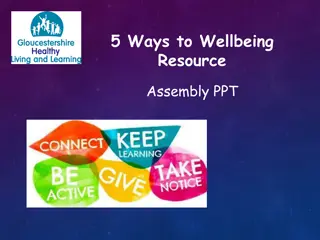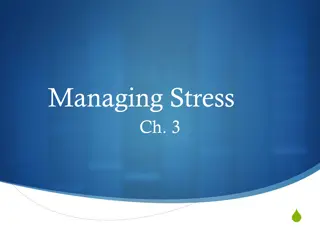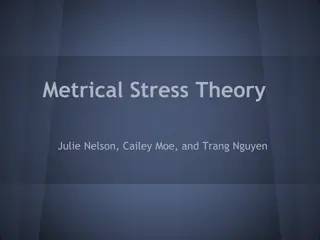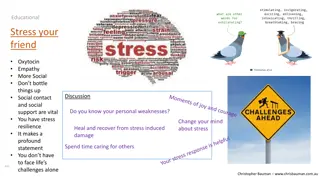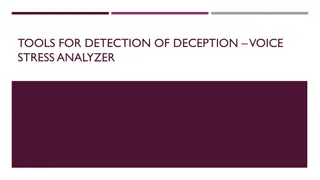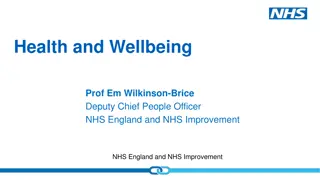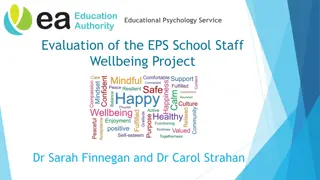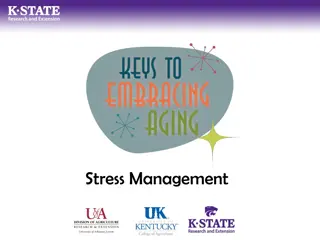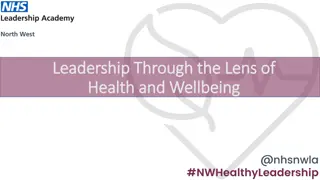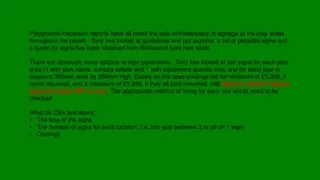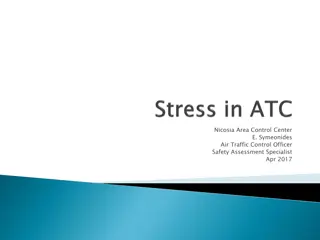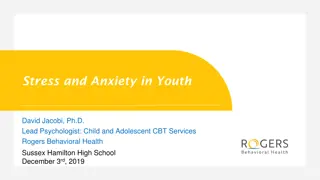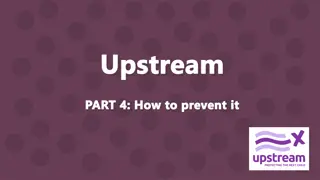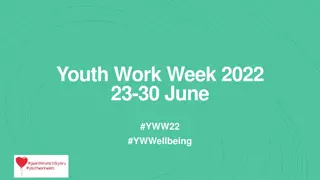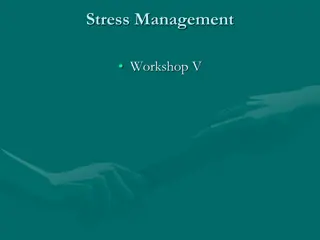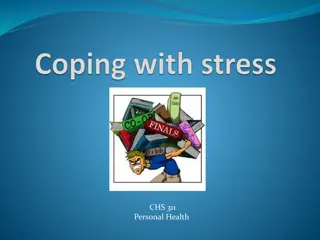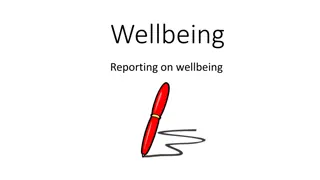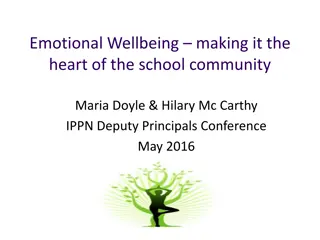Understanding Stress and Wellbeing: Recognizing Signs and Taking Action
Exploring the concepts of stress and wellbeing, this presentation highlights the importance of recognizing early signs of stress and taking steps to manage it effectively. Learn how stress impacts performance, the warning signs to watch for, and the importance of seeking help when needed. Discover practical tips for maintaining mental and emotional health in challenging situations.
Download Presentation

Please find below an Image/Link to download the presentation.
The content on the website is provided AS IS for your information and personal use only. It may not be sold, licensed, or shared on other websites without obtaining consent from the author. Download presentation by click this link. If you encounter any issues during the download, it is possible that the publisher has removed the file from their server.
E N D
Presentation Transcript
Presented by: Corrie Llewellyn Summer Seath Recognising stress and wellbeing Using Charlie Waller Resources
Wellbeing and Stress Wellbeing is about feeling good and functioning well. It encompasses a person s experience of their life, and a judgment of their circumstances compared with social standards and ideals Stress can be defined as a state of mental or emotional strain or tension resulting from adverse or very demanding circumstances. 2
How might you notice when the impact of work is starting to cause you stress? The usual reaction to a potential stressor is for the hypothalamus in the brain to set up a chain reaction stimulating the pituitary gland, which in turn triggers the adrenal gland into producing cortisol, adrenaline and noradrenaline. This flight, flight or freeze mode will help us deal with danger or threat in that moment. However, long-term activation can affect normal body function. All this can lead to immune system suppression, anxiety and depression. It is important to recognise when these stress hormones are impacting on you over a long period. By recognising when this is happening, you can take steps to manage it better. 3
Adapted from Nixon P. (1979) Practitioner Stress 4
Stress Initially, increased stress produces increased performance. Yet, once the person passes a certain point, any more stress results in decreased performance. So, trying harder at this point is unproductive or even counterproductive. The only sensible thing to do is to take a break. People need a certain amount of stress to function well, sometimes called healthy tension or eustress (good stress). However, stress becomes harmful (distress) when there is too much, when it lasts too long or when it occurs too often. One of the first symptoms of distress is fatigue, which is often ignored. If a person reports fatigue, then they should be advised to do something about it before it becomes exhaustion. 5
Its useful to learn to recognise the signs in our thoughts, feelings, appearance or behaviour which might help us or those who care about us to recognise when we need help. Thinking about this can also help us recognise when a friend might need our support too. Unusual behaviour Changes in body language Losing interest Forgetting things Mood swings Tiredness Feeling low Neglecting your appearance Feeling overwhelmed Early Warning Signs
Memory problems Inability to concentrate Poor judgement Thoughts Seeing only the negative Anxious or racing thoughts 7
Moodiness Irritability or short temper Agitation, inability to relax Feelings Feeling overwhelmed Sense of loneliness and isolation General unhappiness 8
Eating more or less Sleeping too much or too little Withdrawal Behaviour Procrastinating or neglecting responsibilities Use of alcohol, cigarettes or drugs for relaxation Nervous habits (e.g. nail biting, pacing) 9
Aches and pains Diarrhoea or constipation Nausea, dizziness Physical Chest pain, rapid heartbeat Loss of libido Frequent colds 10
How might you notice when the impact of work is starting to cause you stress? Thinking about these questions honestly will help you think about whether you are doing enough for your mental (and physical) wellbeing: Am I finding it hard to let go of work and relax? Do I sleep well? Do I spend sufficient time with my friends and family or doing the activities I enjoy? Am I eating healthily? Am I exercising regularly? Am I taking breaks? Am I spending time outside and close to nature? If you have started neglecting these things, think about why. It is useful to recognise what s stopping you. What inner messages are you giving yourself? Do you need to give yourself permission to take breaks? What s stopping you asking for help, delegating tasks or saying no?
Recognising Stress and its affects If the container overflows problems occur Stress flows into the container Unhelpful strategies blocks the tap and stress overflows Helpful coping strategies allows the tap to let the stress out
Burn out The World Health Organisation (WHO) has recently recognised that burn-out is a syndrome conceptualised as resulting from chronic workplace stress that has not been successfully managed It is a state of emotional, physical and mental exhaustion that leaves us feeling helpless, disillusioned, overwhelmed, emotionally drained and unable to meet the constant demands. It is exacerbated by not feeling aligned to the values of our workplace. Burn-out reduces productivity and saps our energy, leaving us feeling increasingly helpless, hopeless, cynical and resentful. Eventually, we may feel like we have nothing more to give. If you are experiencing burn-out, it is really important to reach out and talk to people (but not other negative, burntout colleagues). 13
Stay in wellbeing CREDIT: Commit to developing your own mental wellbeing toolbox Recognise your needs are as important as your clients and your colleagues and/or that you are starting to feel stressed or overwhelmed Experiment and find the best coping strategies for you at home and at work Develop skills to maintain your mental wellbeing Identify where your stressors may be and take action to address these Talk to someone early on if you need to
Being too hard on yourself Being antisocial Taking things to heart Focusing on negatives Staying in bed all day Things to Avoid Being antisocial Being alone all day Smoking, drinking, drugs Taking anger out on others Negative use of social media Keeping things to yourself Worrying too much Hurting yourself
It is very easy to be always on while working at home or to create unhealthy habits, particularly if caring for children/family in the day and working late at night and at weekends. Breaks and rest periods must be taken, otherwise exhaustion and burnout will follow. Allowing some physical rest and time for yourself, and encouraging it for your team members is essential. These are unprecedented times and so acknowledging this and being flexible is key. Work Work- -life balance balance life Set a good example. If you choose to send emails late at night, early in the morning or at the weekend, be explicit about why you are doing this; that it fits with your chosen pattern of working and you do not you expect others to do so. But make sure that you are taking breaks as well if you are not keeping a strict boundary between work time and home time. If scheduled holiday has been planned, ensure employees are taking it and turning off from work. The Charlie Waller guide Working from home: Your Wellbeing Action Plan can help you create the necessary balance and gives tips on ways to protect your mental health during this time.
Now, more than ever, we will need to be mindful of our digital wellbeing. Here are some guidelines Turn off pop-up notifications and alerts on your computer/phone and make use of the do not disturb or sleep functions on your phone while you are working on tasks that require concentration. You will be much more productive and less distracted. A break away from all screens can allow your mind to recharge and you will be more focused when you return. Resist using your phone (social media, checking the news etc.) during breaks. Make sure you get up, move around or do some stretches at regular intervals when working on a computer, preferably every hour. Digital Digital wellbeing wellbeing Find ways to protect yourself from the build-up of emails and the need to react or respond instantly to any digital demand (email, text, WhatsApp and so on). Using your email signature to signal when you are not available and effective use of tools such as out-of-office can help with this. Likewise, respect other people s working patterns which may be different from yours. When working with people using a different working pattern from you, put in place boundaries around when you are and are not contactable. For example, do you really need to respond to emails or messages straight away? Respect your need for home time, arranging online meetings that do not encroach too much on this. This is not being unreasonable or unhelpful, it is being sensible in terms of protecting your own wellbeing. Remember, you will work much more effectively if you have adequate sleep and down time
Know when to seek help Reach out and tell family, colleagues, line mangers how you feel Seek medical advice talk to your GP See a range of guides, apps and events to support the wellbeing of you and your team www.england.nhs.uk/people www.england.nhs.uk/people Lancashire and South Cumbria Resilience Hub (lscresiliencehub.nhs.uk) Lancashire and South Cumbria Resilience Hub (lscresiliencehub.nhs.uk) Lancashire and South Cumbria Resilience Hub (lscresiliencehub.nhs.uk)
Breathe This calming breathing technique for stress, anxiety and panic takes just a few minutes and can be done anywhere. You will get the most benefit if you do it regularly, as part of your daily routine. You can do it standing up, sitting in a chair that supports your back, or lying on a bed or yoga mat on the floor. Make yourself as comfortable as you can. If you can, loosen any clothes that restrict your breathing. If you're lying down, place your arms a little bit away from your sides, with the palms up. Let your legs be straight, or bend your knees so your feet are flat on the floor. If you're sitting, place your arms on the chair arms. If you're sitting or standing, place both feet flat on the ground. Whatever position you're in, place your feet roughly hip- width apart. Let your breath flow as deep down into your belly as is comfortable, without forcing it Try breathing in through your nose and out through your mouth Breathe in gently and regularly. Some people find it helpful to count steadily from 1 to 5. You may not be able to reach 5 at first Then, without pausing or holding your breath, let it flow out gently, counting from 1 to 5 again, if you find this helpful
The Five Ways of Wellbeing Each of the Five Ways to Wellbeing positively enhances wellbeing. When you have these positive experiences, you will change how you think and behave, enhancing your mental capital and becoming emotionally more resilient. Connect Be active Keep learning Give to others Take notice j of the present moment, . 20
Thank you lsc.th@nhs.net https://www.lscthub.co.uk/ Next webinar: Wellbeing Action Plans (the five ways of wellbeing) Mon, July 19th 12:00-13:00 21


